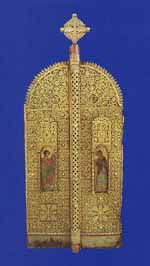 Lazar
Seferovic Lazar
Seferovic
Icons
The Dimitrijevic-Rafailovic Icon-Painting School of the Bay of Kotor
The noblest Post-Classical art, Byzantine art, governed European mind as, for example, the Paris'one has done in the 20th century.
The influence of the eastern painting idiom continued to live in the late figures of the icons of Savina and the Dimitrijevic-Rafailovic Icon-Painting School of the Bay of Kotor. There is also the obvious impact of other influences besides the Byzantine one, such as: Italian-Greek, Romanesque, Gothic, Renaissance.
 The
greatest number of icons was produced in the last decade of the
13th century and the first decade of the 14th century, that is the
years when a decorated partition between the altar and the nave
became common. The arrival of the Turks did not break the line of
icon creation, but there was a decrease in icon production and decay
of artistic expression. In the 17th century a strong wave of western
painting idiom flowed over the late Greek iconography, spread to
Russia, and also to the local icon-painting schools. The 17th century
was the golden era of icon painting in Montenegro. It began with
the Hilandar master Georgije Mitrofanovic from Moraca monastery
and was continued by master Radul, whose experience was exploited
by the painters of the long-lived family of artists from the Bay
of Kotor, the Dimitrijevic-Rafailovic family of Risan, in the course
of the 17th, 18th and 19th century The
greatest number of icons was produced in the last decade of the
13th century and the first decade of the 14th century, that is the
years when a decorated partition between the altar and the nave
became common. The arrival of the Turks did not break the line of
icon creation, but there was a decrease in icon production and decay
of artistic expression. In the 17th century a strong wave of western
painting idiom flowed over the late Greek iconography, spread to
Russia, and also to the local icon-painting schools. The 17th century
was the golden era of icon painting in Montenegro. It began with
the Hilandar master Georgije Mitrofanovic from Moraca monastery
and was continued by master Radul, whose experience was exploited
by the painters of the long-lived family of artists from the Bay
of Kotor, the Dimitrijevic-Rafailovic family of Risan, in the course
of the 17th, 18th and 19th century

The Dimitrijevic-Rafailovic Icon-Painting School of the Bay of Kotor
gave eleven painters in five generation, who left thousands of icons,
almost a hundred iconostases, woodcarving and fresco compositions,
mainly in village churches. The progenitor of the School was Dimitrije
the »dascal« (the teacher) – Miter Dascalo detto Pizas, as it was
written in the »Katastik« (cadastre) in Risan.
The items of the Icon-Painting School of the Bay of Kotor are kept
in the rich collection of the Regional Museum at Topla (Herceg-Novi)
and in the treasury of Monastery Savina. Some of the works show
certain artistic expressions often limited by provincial inspiration
range and manner.

The icon of St. Nikola (Nicholas) from 1735, a gift from Hilandar,
kept in the treasury of Monastery Savina is of high artistic value.
We should also mention four representative works of Russian icon
painting and icons of the Greek-Levantine production also kept in
the treasury of Monastery Savina.
//
Projekat Rastko-Boka / Umetnost //
[ Promena pisma | Pretraživanje | Mapa Projekta | Kontakt | Pomoć ]
©
2001. "Projekat
Rastko - Biblioteka srpske kulture na Internetu"; Tehnologije, izdavaštvo i agencija "Janus"; kao i nosioci pojedinačnih autorskih prava. Nijedan deo ovog sajta ne smije se umnožavati ili prenositi bez prethodne saglasnosti. Za zahtjeve kliknite ovdje.
|



